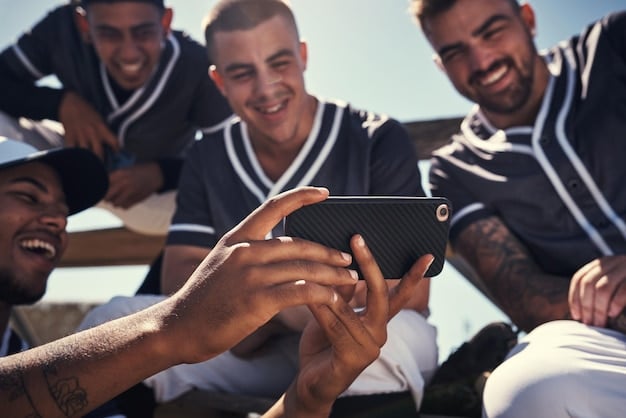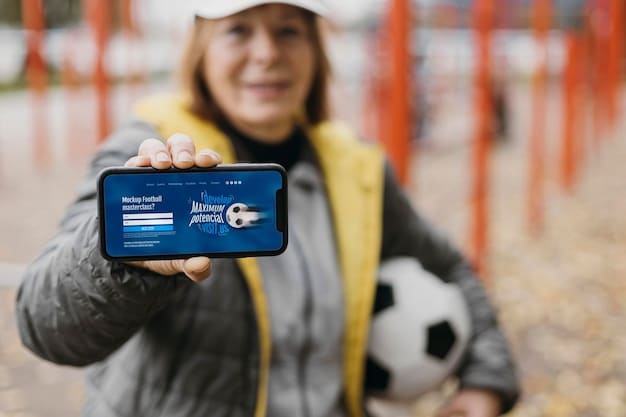US Soccer Fan Engagement: Apps, Social Media & 25% Interaction Boost

Achieving a 25% increase in interaction for US soccer fans hinges on strategically leveraging mobile applications and social media platforms to foster deeper engagement, offer exclusive content, and create interactive communities, thereby transforming passive spectators into active participants.
The landscape of fan engagement in US soccer is undergoing a significant transformation. With digital technologies rapidly evolving, the opportunity to deepen connections between teams, leagues, and their supporters has never been greater. This article explores how a strategic fusion of mobile applications and social media can unlock a substantial increase in fan interaction, potentially boosting engagement by a remarkable 25%.
The Digital Frontline: Mobile Apps as Engagement Hubs
In the quest to elevate fan engagement, mobile applications are emerging as indispensable tools. They offer a direct, personalized channel for interaction, moving beyond static websites to deliver dynamic experiences. For US soccer, where the fan base is diverse and digitally native, a robust mobile app strategy is paramount.
Personalized Fan Experiences
Modern fans demand more than just scores; they crave personalized interactions that reflect their unique interests. A well-designed mobile app can cater to this by providing customized content feeds, push notifications tailored to favorite teams or players, and exclusive access to behind-the-scenes glimpses. This level of personalization significantly enhances the user’s connection to the sport and its affiliated entities.
The ability to integrate ticketing, merchandise, and even in-stadium navigation within a single app streamlines the fan journey, making it more convenient and enjoyable. This holistic approach ensures every touchpoint reinforces their devotion to the team.
- Real-time match statistics and play-by-plays.
- Exclusive interviews and documentary content.
- Personalized merchandise recommendations.
- Interactive fan polls and prediction games.
For instance, an app could learn a fan’s preferred player and then offer exclusive video clips or news updates specifically about them. This goes beyond generic fan engagement, fostering a sense of individual recognition and value.
Interactive Features and Gamification
Engagement isn’t just about consumption; it’s about participation. Mobile apps can transform passive viewing into active involvement through gamification and interactive features. Fantasy leagues, prediction challenges, and trivia games embedded within the app can significantly boost user retention and time spent on the platform. These elements tap into the competitive spirit of fans, encouraging them to return frequently.

Beyond individual games, leaderboards and virtual rewards can create a thriving community among users. This sense of competition and achievement not only engages users but also inspires them to share their experiences, effectively turning app users into brand ambassadors. The more interactive the app, the more reasons fans have to engage daily, not just on match days.
Monetization and Data Collection
While the primary goal is engagement, mobile apps also present significant opportunities for monetization and invaluable data collection. In-app purchases for premium content, virtual currency, or exclusive digital collectibles can generate revenue. More importantly, every interaction within the app provides data about fan preferences, behaviors, and demographics. This information is gold for marketing teams, allowing them to refine strategies and tailor offerings with unprecedented precision.
Understanding what content resonates most, which features are most used, and when fans are most active allows teams and leagues to optimize their digital offerings continuously. This data-driven approach is critical for achieving and sustaining the targeted 25% increase in interaction.
In summary, a well-executed mobile app strategy provides a centralized platform for personalized content, interactive experiences, and sustainable growth, creating an irreplaceable digital connection with the US soccer fan base.
Social Media: Amplifying Voices and Building Communities
While mobile apps serve as central hubs, social media platforms are the dynamic ecosystems where conversations ignite, opinions are shared, and fandom truly thrives. Leveraging social media effectively is crucial for extending reach, fostering dialogue, and building robust communities around US soccer.
Real-Time Engagement and Content Distribution
Social media’s strength lies in its immediacy. During live matches, platforms like Twitter, Instagram, and Facebook become virtual stadiums, where fans react to every goal, tackle, and referee decision in real-time. Teams and leagues can capitalize on this by providing instant updates, engaging with fan comments, and sharing highlights as they happen. This creates a shared, synchronous experience that amplifies excitement and creates a sense of belonging.
Moreover, social media serves as a powerful distribution channel for mobile app content. Teasers for exclusive app videos, links to interactive polls, or notifications about new features can drive traffic directly to the app, reinforcing the integrated digital strategy.
- Live Q&A sessions with players after matches.
- Behind-the-scenes stories on Instagram and TikTok.
- Fan-generated content spotlights.
- Timely reactions to in-game moments.
Beyond match days, social media maintains the connection by sharing practice footage, player interviews, and community initiatives, keeping the fan base consistently engaged.
User-Generated Content and Fan Spotlights
One of the most authentic ways to boost engagement is by empowering fans themselves. Encouraging user-generated content (UGC) through hashtags, photo contests, and video challenges transforms fans from passive consumers into active creators and advocates. When a team shares a fan’s creative content, it not only rewards that individual but also inspires countless others to participate, creating a virtuous cycle of engagement.
Platforms like TikTok and Instagram are particularly effective for this, allowing fans to showcase their passion in innovative and visually appealing ways. Spotlighting these contributions signals that fan voices are valued and an integral part of the team’s identity.
This approach isn’t just about generating content; it’s about building a community where fans feel seen, heard, and appreciated. It adds a layer of authenticity to the fan experience that traditional marketing campaigns often lack, making the connection much stronger and more personal.
Strategic Partnerships and Influencer Marketing
To broaden reach and tap into new demographics, US soccer entities can leverage strategic partnerships and influencer marketing on social media. Collaborating with popular soccer influencers, sports commentators, or even local community leaders can introduce the sport to new audiences who might not otherwise be reached through traditional channels. These partnerships can take various forms, from sponsored content to joint campaigns, each designed to drive engagement and attract new fans.
Choosing influencers whose values align with the sport and who genuinely appeal to the target demographic ensures authenticity and impact. This method opens pathways to conversations and fan communities that might be otherwise inaccessible, significantly contributing to the overall 25% interaction increase goal.
Social media, therefore, acts as a vibrant public square, connecting, amplifying, and celebrating the diverse and passionate community of US soccer fans, complementing the personalized experience offered by mobile applications.
Synergy: Integrating Apps and Social Media for Maximum Impact
The true potential for increasing fan interaction by 25% doesn’t lie in using mobile apps or social media in isolation, but rather in a seamless, synergistic integration of both. When these platforms communicate and reinforce each other, they create a powerful, unified digital ecosystem that captures and sustains fan attention.
Cross-Promotion and Content Flow
A fundamental aspect of integration is the intelligent cross-promotion of content and features across both platforms. For example, a team’s social media channels can regularly promote exclusive content or interactive games available only on their mobile app, driving downloads and usage. Conversely, the mobile app can embed social media feeds, allowing users to see real-time social conversations and share app content directly to their social profiles. This creates a natural flow of engagement, ensuring fans are always aware of where to go for the best experience.
Consider a scenario where an in-app poll’s results are immediately shared on Twitter, inviting further discussion. Or, an exclusive interview on the app is teased with a gripping short clip on Instagram pushing viewers to the app for the full story. Such integrated content strategies foster habitual engagement across both channels.
Unified Fan Profiles and Personalization
The holy grail of integrated digital engagement is the creation of a unified fan profile. By linking a fan’s app activity with their social media interactions, teams and leagues can build a comprehensive understanding of their supporters. This unified profile allows for even deeper personalization, ensuring that content served on the app is relevant to their social media interests, and vice versa. Imagine a fan who frequently tweets about a specific player; the app could then prioritize news and updates about that player.
This deep level of insight enables highly targeted messaging, improved customer service, and more relevant marketing efforts, ensuring every interaction feels tailored and meaningful to the individual fan. It’s about building a 360-degree view of the fan to serve them better.
Event Integration and Hybrid Experiences
The integration extends beyond the digital realm into live events. Mobile apps can serve as second-screen experiences during matches, offering complementary stats, replays, and interactive elements. Social media, in turn, can be used to run real-time contests for in-stadium attendees, encouraging participation and sharing. QR codes within the stadium could link directly to app features or social media filters, blurring the lines between the physical and digital fan experience. This hybrid approach caters to the modern fan’s desire for immersive, multi-platform engagement, truly maximizing every moment of interaction.
By treating mobile apps and social media as interdependent pillars of a larger engagement strategy, US soccer can unlock unprecedented levels of fan interaction, making the 25% increase not just ambitious, but eminently achievable.
Measuring Success: Metrics and Benchmarking for a 25% Boost
Achieving a 25% increase in fan interaction isn’t a goal; it’s a journey that requires rigorous measurement and continuous optimization. Defining clear metrics, establishing benchmarks, and consistently analyzing data are paramount to tracking progress and identifying areas for improvement in the digital engagement strategy for US soccer.
Key Performance Indicators (KPIs) for Engagement
To quantify the 25% boost, specific Key Performance Indicators (KPIs) must be defined and tracked. These extend beyond simple follower counts or app downloads to deeper engagement metrics. For mobile apps, these might include daily and monthly active users (DAU/MAU), session duration, feature usage rates (e.g., how many fans use the prediction game), and conversion rates for in-app purchases. For social media, relevant KPIs include engagement rate (likes, comments, shares per post), reach, mentions, and sentiment analysis.
It’s also crucial to monitor cross-platform metrics, such as referral traffic from social media to the app, or app content shares on social media. This comprehensive view illuminates the true impact of the integrated strategy, providing actionable insights for continued growth.
- Average time spent on app/social platforms.
- Number of unique interactive feature uses (e.g., polls, games).
- Rate of user-generated content submission/sharing.
- Clicks on links driving traffic between app and social.
Each of these metrics offers a window into how deeply and frequently fans are interacting, allowing for precise adjustments to content and strategy.
Establishing Baselines and Setting Targets
Before aiming for a 25% increase, it’s essential to establish a baseline of current fan interaction across all digital channels. This involves a thorough audit of existing app analytics, social media insights, and any other relevant data sources. Once the baseline is understood, clear, realistic, and measurable targets for each KPI can be set to contribute to the overall 25% goal. These targets should be broken down into weekly, monthly, and quarterly objectives to maintain momentum and allow for frequent evaluation.

For example, if the current average daily app session is 3 minutes, a target might be to increase it to 3.75 minutes. If the social media engagement rate is 2%, aim for 2.5%. These granular targets make the overarching 25% goal more manageable and provide clear guidance for all digital marketing efforts.
Iterative Optimization and A/B Testing
Achieving significant engagement growth is rarely a linear process. It requires an iterative approach of analysis, adaptation, and optimization. Regular performance reviews of all KPIs—at least monthly—are essential to understand what’s working and what isn’t. A/B testing different content types, push notification strategies, social media post formats, or app features can provide valuable insights into what resonates most with the US soccer audience. For instance, testing two different headlines for a social media post or two designs for an in-app game can reveal which approach drives higher interaction.
This continuous feedback loop, driven by data, ensures that digital engagement strategies are not static but evolve in response to fan behavior and industry trends. By embracing this adaptive mindset, US soccer can confidently work towards and sustain a 25% increase in fan interaction, creating a more vibrant and connected community.
Challenges and Considerations in Digital Fan Engagement
While the potential for boosting US soccer fan engagement through mobile apps and social media is immense, this digital frontier is not without its challenges. Navigating these obstacles effectively is crucial for sustained growth and ensuring the 25% interaction increase target is not just met, but maintained.
Content Overload and Attention Span
In today’s digital age, consumers are bombarded with content from countless sources. This “content overload” makes it challenging for any single entity, including soccer teams and leagues, to capture and retain fan attention. The average human attention span is reportedly shrinking, making it imperative for content to be concise, engaging, and highly relevant. For US soccer, this means moving beyond generic updates to deliver truly valuable and compelling narratives that cut through the noise, whether through short-form video on TikTok or exclusive long-form features in an app.
Stale or repetitive content can quickly lead to user fatigue and app uninstalls or social media unfollows. Constant innovation in content creation and delivery, tailored to the unique attributes of each platform, is key to staying fresh and captivating the audience.
Data Privacy and Security
As digital engagement relies heavily on collecting and utilizing fan data, ensuring robust data privacy and security measures is paramount. Fans are increasingly aware of their digital rights and concerned about how their personal information is used. Any breach of trust can lead to significant reputational damage and a sharp decline in engagement. Teams and leagues must adhere strictly to data protection regulations (like GDPR, even if focused on US audiences, as best practices often align globally) and be transparent with fans about data collection practices across both mobile apps and social media platforms. Building and maintaining fan trust through responsible data handling is foundational to sustained engagement.
Monetization vs. User Experience
Striking the right balance between monetization efforts and maintaining an optimal user experience is a delicate act. Overly aggressive advertising, excessive in-app purchases, or paywalls for basic content can alienate users and drive them away. While revenue generation is important for sustainability, it should never come at the expense of fan enjoyment and convenience. The most successful digital platforms integrate monetization seamlessly, offering value that fans are willing to pay for, rather than imposing intrusive commercial interruptions. This often involves exclusive content or enhanced features that genuinely add value rather than subtract from the experience.
Successfully navigating these challenges requires a strategic approach that prioritizes fan experience, innovation, and trust, ultimately reinforcing the long-term value of digital engagement in US soccer.
The Future Horizon: Innovations in Fan Engagement
As technology continues its rapid advancement, the future of US soccer fan engagement promises even more immersive and personalized experiences. Looking beyond the current capabilities of mobile apps and social media, innovative technologies are poised to redefine how fans interact with their favorite sport. Embracing these emerging trends will be key to not just achieving, but exceeding the 25% interaction increase.
Augmented Reality (AR) and Virtual Reality (VR)
AR and VR offer unprecedented opportunities to bring the game closer to fans, regardless of their physical location. Imagine an AR feature within a mobile app that allows fans to overlay virtual goal celebrations onto their living rooms or project 3D player statistics during a live game. VR could transport fans to virtual stadiums, offering immersive 360-degree views from the sideline or even the locker room, blurring the lines between spectator and participant. These technologies can create highly engaging, memorable experiences that conventional media simply cannot replicate.
- Virtual stadium tours accessible from anywhere.
- AR filters for social media that add team effects to fan selfies.
- VR experiences for training simulations or player perspectives.
- Interactive overlays on live broadcasts enriching viewing.
Early adoption of these technologies, perhaps even through pilot programs, could position US soccer as a leader in sports innovation, attracting tech-savvy fans and deepening the engagement of existing ones.
Artificial Intelligence (AI) and Machine Learning (ML)
The power of AI and ML will revolutionize personalization. Beyond current capabilities, AI can analyze vast amounts of fan data to predict preferences with uncanny accuracy, recommending not just relevant content, but also ideal times for interaction. Chatbots powered by AI can provide instant, intelligent fan support, answering questions about tickets, merchandise, or even historical game facts, available 24/7. ML algorithms can optimize content delivery across apps and social media, ensuring the right message reaches the right fan at the opportune moment, maximizing engagement efficacy.
This intelligent automation means less guesswork and more precision in tailoring experiences, making every interaction feel uniquely designed for the individual fan, further cementing their loyalty and dramatically increasing relevant interaction points.
Blockchain and NFTs for Fan Loyalty
Blockchain technology and Non-Fungible Tokens (NFTs) are emerging as powerful tools for enhancing fan loyalty and offering unique digital collectibles. Teams could issue NFTs representing iconic moments, player milestones, or exclusive fan club memberships, providing tangible digital assets that fans can own, trade, and display. This creates a new layer of engagement, connecting fandom with digital ownership and scarcity. Blockchain could also underpin secure, transparent loyalty programs, rewarding fans with verifiable digital badges or exclusive access based on their engagement levels. This taps into the growing digital collector economy and offers novel ways to acknowledge and reward dedicated supporters.
The strategic incorporation of AR, VR, AI, ML, and blockchain is not just about adopting new tech; it’s about pioneering new forms of immersive, personalized, and rewarding fan experiences. By doing so, US soccer can ensure its digital engagement strategy remains at the forefront, captivating a new generation of fans and sustaining exponential growth for years to come.
| Key Point | Brief Description |
|---|---|
| 📱 Mobile Apps | Centralized hubs for personalized content, interactive games, and streamlining fan experiences. |
| 🌐 Social Media | Amplifies voices, fosters real-time engagement, and builds vibrant fan communities. |
| 🤝 Synergy & Integration | The combined power of apps and social media creates a cohesive, powerful digital experience. |
| 📈 Measuring Success | KPI tracking, baseline setting, and iterative optimization are crucial for sustained growth. |
Frequently Asked Questions About US Soccer Fan Engagement
Fan engagement is vital for US soccer’s growth because it transforms casual viewers into loyal supporters, driving revenue through merchandise and tickets, and expanding the sport’s overall cultural footprint. Highly engaged fans are more likely to attend games, participate in events, and advocate for their teams, creating a stronger and more sustainable ecosystem for soccer in the US.
Mobile apps can significantly boost fan interaction by offering personalized content, real-time statistics, exclusive behind-the-scenes access, and interactive features like games or polls. They also provide convenient access to ticketing and merchandise, creating a centralized hub for all fan needs and fostering deeper, more frequent engagement beyond match days.
Social media platforms are essential for real-time engagement, content distribution, and community building. They allow teams to share moments, interact directly with fans, and encourage user-generated content, making fans feel heard and valued. Social media extends reach, amplifies messages, and creates a vibrant, responsive environment for fans to express their passion.
Measuring a 25% increase involves tracking key performance indicators (KPIs) like daily/monthly active users on apps, social media engagement rates (likes, comments, shares), session duration, and click-through rates between platforms. Establishing a baseline and setting clear, measurable targets for each metric allows teams to monitor progress and adjust strategies iteratively, ensuring data-driven growth.
Emerging technologies like Augmented Reality (AR) and Virtual Reality (VR) will offer immersive experiences, transporting fans virtually onto the pitch or into the locker room. Artificial Intelligence (AI) and Machine Learning (ML) will further personalize content and interactions. Additionally, blockchain and NFTs could provide unique digital collectibles and loyalty rewards, redefining fan ownership and engagement.
Conclusion
Achieving a 25% increase in US soccer fan interaction is an ambitious yet entirely attainable goal through the strategic integration of mobile applications and social media. By creating personalized, interactive digital experiences, fostering vibrant communities, and continuously optimizing based on robust data, teams and leagues can forge deeper, more meaningful connections with their supporters. The future of fan engagement lies in a dynamic, unified, and technologically forward-thinking approach that transforms passive viewers into passionate, lifelong advocates, driving the sport’s growth across the nation.





